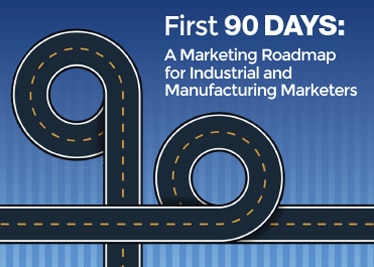First 90-Days Marketing Roadmap for Industrial and Manufacturing Marketers

Written by Dan Konstantinovsky
Strategic Marketing, RH Blake
![]()
Your first 90 days are critical to building a structured industrial or manufacturing marketing program.
Maybe you’re new to your marketing position and are looking for guidance with strategy. Or you just feel like it’s time for a reset on your company’s approach to connecting with prospects and deepening relationships with current customers.
In either case, the following recommendations should be part of your 90-day marketing roadmap to ensure that your program has the best chance for success.
Think in terms of 30-day action blocks, with each segment laying the foundation for the one to follow. Equally important is to have reasonable expectations, with your goal to drive sustainable success in the future, not in the first few days. By following these guidelines, you’ll have a framework that can support growth while allowing for adaptation to industry changes.
First 90-Days Marketing Plan for Industrial and Manufacturing Marketers: What to focus on days 1 – 30?
The goal of the first 30 days is to get a better understanding of your current marketing program, marketing team, and customer base and target market. This begins with crystalizing your company’s message and the value propositions of your products and services. How is your company brand perceived in the marketplace? Has it changed over the years? And how does that perception align with the one you want it to have? In other words, does your messaging match your goals, and is it the right message for the market you are targeting?
Communication is also needed between numerous departments to clarify expectations and deliverables. For example, is the marketing team and the sales department on the same page when it comes to defining leads, sales qualified leads (SQLs) and marketing qualified leads (MQLs)? Do your two systems dovetail to ensure follow-up of new leads and data tracking? Have you coordinated your marketing plans with operations and product management to confirm the new product being promoted is ready for rollout?
Current industrial or manufacturing marketing program: processes and results
Once you’ve completed that process, move onto looking at the plan you currently have in place. Here are some questions to help you analyze your current strategy and identify gaps in knowledge or activities:
- What are our defined product or service offerings?
- What are the prioritized target markets?
- Who are the target customer personas?
- Who are our key competitors?
- What are our competitive differentiators?
- How well has our plan been performing?
Performance metrics will depend on the extent and type of system or technology you have in place and what it is measuring. You should have a baseline in place that measures the following:
- Lifetime Customer Value (LTV) – the projected net profit a customer will generate during their lifetime working with you.
- Customer Acquisition Cost (CAC) – the cost associated with convincing a prospect to buy your offering, including research, marketing, and advertising costs.
- Cost per Lead (CPL) – the cost of your overall marketing plan (including specific campaigns) divided by the number of leads generated.
Customer research
A key element of a marketing plan is a solid understanding of your current customer base, which you can learn from a quarterly structured research program.
Some questions to help you gather data on your customer base include:
- What drives customers to consider the offerings we provide? (Cost reduction? Performance improvement? Risk avoidance? Other factors?)
- What is the typical buying process from end-to-end and purchasing cycle for our target customers? (It’s been estimated that B2B buyers complete nearly 60% of their buying cycle before contacting a supplier.)
- What are our customers’ pain points? What problem(s) do they need to solve?
- How do prospects find our products or services, and what do we do to keep the connection viable?
- What drives prospects to continue and deepen a relationship?
- What strategies are in place to retain customers?
The last is particularly important, because the cost of attracting a new customer is five to 25 times more expensive than retaining an existing one. While customer acquisition is a driver for businesses, it’s the retention figures that demonstrate your company’s standing in the minds of its customers. At the same time, you need to evaluate the profitability of your customers because not all are worth retaining from an ROI perspective.
First 90-Days Marketing Plan for Industrial and Manufacturing Marketers: What to focus on days 31 – 60?
Now that you know what has been working (or not) as well as what matters to your customers, it’s time to make any needed changes to your marketing plan to increase its effectiveness. What channel mix and tactics will be most effective based on the customer research you undertook in stage 1? Your strategy should align with that research and decision-making process.
Consider all the elements that will go into making the plan work: the marketing infrastructure, your team and the budget. Start with technology:
- Do you have a well-defined online presence that is easy to navigate?
- Do you have software to capture leads and automate marketing responses as well as measure website analytics, marketing and lead generation results?
- Do all your pieces work well together or are there gaps that allow valuable information to be lost?
Now what about your team: Do you have the right people in place to enact your plan? Do they have the training and resources they need? Should you schedule training session with your software vendor to make sure your team can maximize the technology?
And of course all this costs money – have you calculated your budget for the technology and manpower, taking into account LTV, CAC and CPL? Just as a frame of reference, the average manufacturer spends about 2.7% of its revenue on marketing – more if products are also sold online. Compare this to other industries, such as consumer services (17.4%), service consulting (9.4%) and tech/software/biotech (8.5%), just to name a few.
Finally, based on your marketing budget, what’s your expected ROI? How many SQLs and the MQLs do you expect to generate?
First 90-Days Marketing Plan for Industrial and Manufacturing Marketers: What to focus on days 61 – 90?
This is when you stop planning and start doing. It’s time to execute your plan, possibly in stages, with the first focusing on the highest-priority channels or markets that promise to deliver the best ROI. Monitor results so you can make any minor adjustments on the fly. Stay in close communication with the sales team to track outcomes.
First 90-Days Marketing Plan for Industrial and Manufacturing Marketers: What to focus on Days 90+? Review, Revise, Repeat
A common mistake when it comes to industrial and manufacturing marketing plans is to follow the “develop-implement-repeat” approach. After the plan is created and put into action, there’s only minimal review of how well it is working or what changes might be required.
However, a marketing program is not a static formulaic process but a living entity that needs to adapt and change organically based on results and goals. Embedded in each of these steps and activities should be a continuous improvement loop. Build in a review process at various stages to monitor progress and create a mechanism for capturing and communicating to your team what you have learned.









